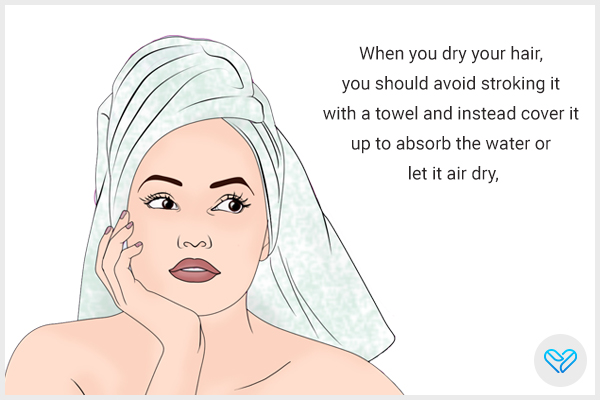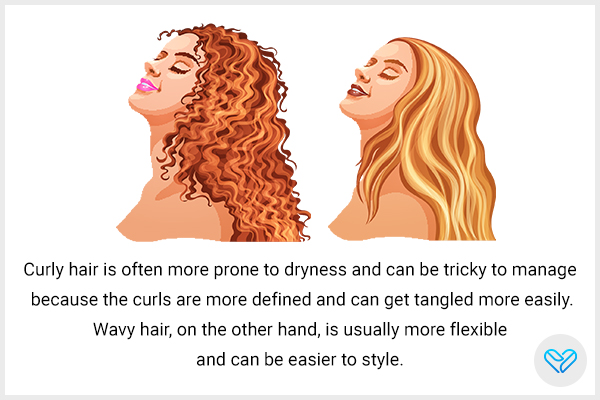In this article:
Wavy hair can be considered someplace between straight and curly hair. It’s represented by loose, easygoing spirals that can vary from modest waves to more defined coils.

While wavy hair can be spectacular looking, it can also be challenging to maintain. Wavy hair is inclined to get frizzy and knotted up, and it can easily renounce its form without proper care.
This article will investigate the reasons that make your hair wavy, the various kinds of wavy hair, and its proper maintenance to keep it healthy and good-looking.
Taking Care of Wavy Hair: What to Do and What Not to Do?
When it comes to the maintenance of wavy hair, you want to make sure you don’t do something that can cause damage. Damaged hair is fragile and can readily break, which can make it frizzy and unhealthy.
And if you keep damaging your hair with improper hair care practices, it might even start thinning or falling out. (1)
To avoid harming your wavy hair, you may need to make some of the following modifications to your hair care regimen.
1. Shampoo your hair correctly
When you wash your hair, be gentle and do not rub the shampoo into your hair too strongly. Rather, massage it into your scalp delicately and let it flow through the length of your hair when you rinse it. (1)(2)
2. Use conditioner to moisturize your hair
Moisturizing your hair is crucial for maintaining wholesome waves. So, another shift you can make is to invariably apply conditioner after shampooing. Doing so helps to keep your hair moisturized and less susceptible to breakage. (1)
3. Don’t overwash

Overwashing can deprive your hair of its natural oils, which can lead to dryness and frizz. Wash your hair every other day or every 2 days to keep it clean and looking good. (2)
4. Don’t comb/brush hair too aggressively and use a wide-tooth comb
Wavy hair can be prone to knotting. When you brush or comb your hair to remove these knots, do not do it too aggressively. Based on the texture of your wavy hair, you might need a wide-tooth comb. (1)
Also, according to research, combing extremely spiral hair is easier when the hair is slightly wet compared to when it’s dry, while the opposite is true for wavy to straight hair.
This means that if you have wavy hair, you need to comb it when it’s dry to avoid too much breakage. (3)
Note: You don’t need to brush your hair 100 times a day, as some people say. In fact, that can do more harm than good!
5. Protect hair from heat styling
When using styling tools such as blow-dryers, curling rods, or flat irons, do so on the lowest heat setting possible and cap their use to once a week or even less often.
You can also try hairdos that don’t mandate heavy styling products and refrain from pulling your hair back too tightly in ponytails or braids. (1)
6. Avoid drying your hair with a towel rub

When you dry your hair, avoid stroking it with a towel; instead, cover it up to absorb the water or let it air-dry.
According to experts, air-drying is the right way to go. But if you’re in a rush and need to use a blow-dryer, they suggest using a diffuser attachment and keeping the settings at medium heat and low pressure to minimize damage.
It’s better to at least let 20% of your hair dry naturally. That way, you’ll be able to preserve your hair’s natural texture and avoid frizz.
7. Space hair treatments and use sun protection
If you color, perm, or relax your hair, space out these treatments as much as possible and use conditioner regularly.
When you are out in the sun, protect your hair by wearing a hat or using a leave-in conditioner containing zinc oxide. (1)
Causes of Wavy Hair
The way your hair looks – whether it is straight, wavy, or curly – and how thick each strand is mostly depend on your genes. Various genes control hair texture and thickness, which differ across ethnic backgrounds.
Apart from genetics, other things can also affect the appearance of your hair. Hormones, some medicines, and chemicals such as those found in hair relaxers or perms can alter the structure of your hair. These changes can be permanent or temporary.
Additionally, as you age, your hair texture might change. (4)
Types of Hair
Have you ever noticed how different people have different types of hair? Some people have straight hair, some have wavy hair, some have curly hair, and some have super coily hair.
The reason for this variety has to do with the shape of the hair follicles, which are a part of your hair structure. (5)(6)
Hair follicles are like tiny little tunnels in the scalp where your hair grows out of. The shape of these tunnels is determined by your genes.
If your hair follicles are shaped like an S, your hair will grow out curly. If your hair follicles are straight, your hair will grow out straight. And if your hair follicles are somewhere in between, you’ll have wavy hair. (6)
There are different ways to categorize the different types of hair. Most hair stylists use a system that breaks it down into four types: straight, wavy, curly, and coily.
Within these categories are different subcategories that describe the exact texture and shape of the hair. For this reason, wavy hair comes in different types, ranging from subtle waves to more defined curls.
The different types of wavy hair are:
- Type 2A: This is the subtlest type of wavy hair. The waves are loose and almost very fine.
- Type 2B: This type of wavy hair has more defined waves that form an “S” shape.
- Type 2C: This type of wavy hair has a more pronounced “S” shape.
Difference Between Wavy Hair and Curly Hair

Have you ever wondered what the difference is between wavy hair and curly hair? It turns out they’re not the same thing!
The curls of wavy hair are a bit more relaxed and flowy, while curly hair has tighter curls that can bounce back when you play with them. It’s like the difference between a wave and a spring.
Not only do the curls look different, but the texture of wavy and curly hair is also distinct. Curly hair is often more prone to dryness and can be tricky to manage because the curls are more defined and can get tangled more easily. Wavy hair, on the other hand, is usually more flexible and can be easier to style.
So, next time someone tells you they have wavy hair, don’t assume it’s the same as curly hair. They might just have a different type of hair wave going on!
Most-Asked Questions
Can wavy hair be straightened?
Yes, wavy hair can be straightened with heat styling tools such as a flat iron, but limit heat styling and use a heat protectant spray.
How can enhance wavy hair naturally?
You can enhance your wavy hair naturally if you use a diffuser on your hairdryer or sleep with a loose bun or braid.
Is it better to brush or comb wavy hair?
Use a wide-tooth comb on wavy hair to prevent damage and to detangle gently.
Can wavy hair become curly?
Yes, in some cases, wavy hair can become curly due to hormonal changes or aging, but the change depends on individual genetics and hair type.
Final Word
Wavy hair can be stunning, but it requires a little extra effort to keep it healthy and looking great. By using the right products and ensuring proper care, you can maintain the natural shape of your waves and prevent damage.
Also, by understanding the type of wavy hair you have and how to take care of it, you can keep your hair healthy, gorgeous, and full of life.
- Was this article helpful?
- YES, THANKS!NOT REALLY


